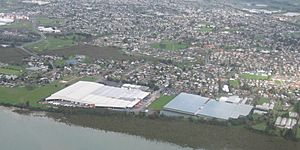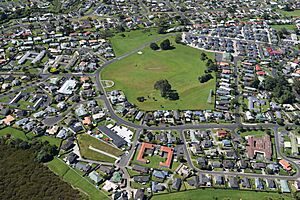Favona facts for kids
Quick facts for kids
Favona
|
|
|---|---|
|
Suburb
|
|

Favona from the air, looking south.
|
|
| Country | New Zealand |
| Local authority | Auckland |
| Electoral ward | Manukau ward |
| Local board | Māngere-Ōtāhuhu Local Board |
| Area | |
| • Land | 261 ha (645 acre) |
| Population
(June 2023)
|
|
| • Total | 11,160 |
|
|
||
Favona is a busy suburb in Auckland, New Zealand. It is mostly known for its many businesses and factories. Favona is part of the wider Māngere area. It is managed by the Auckland Council, which helps run the city.
Contents
What's in a Name?
The exact reason for the name Favona is a bit of a mystery. It might be linked to the cattle owned by the Robertson family, who used to farm in Māngere. There was also a famous racehorse named Favona in the 1890s. This horse was raised on John Lennard's farm in Māngere. Later, in 1899, a man named Hugh Mosman bought a large farm here. He called his property Favona Farm, which is likely how the area got its name.
Favona's Landscape
Favona is located south of the Māngere Inlet, which is a body of water. It is also near two creeks, Tararata Creek and Harania Creek. A very interesting natural feature here is the Boggust Park Crater. This crater is part of the Auckland volcanic field. Scientists believe it erupted about 130,000 years ago, making it the oldest known volcano in the Auckland area!
A Look Back: Favona's History
Early Māori Life
People from the Tāmaki Māori tribes first settled in the coastal Māngere area around the 14th century. More permanent settlements appeared in the 15th century. This area was important because it was close to Te Tō Waka. This was a short portage, or land path, that connected the Manukau Harbour to the Waitematā Harbour at Ōtāhuhu. It was a vital route for travel and trade by waka (canoes).
European Settlement and Changes
In 1836, a missionary named William Thomas Fairburn arranged a large land sale. This sale involved Māori chiefs, including Pōtatau Te Wherowhero, and covered much of what is now South Auckland. The idea was to bring peace, but it's not clear if the chiefs fully understood or agreed to everything. Māori people continued to live in the area.
The New Zealand government later reduced the size of Fairburn's land. They then divided much of it for European settlers. Until the 1860s, Māori people in the Manukau Harbour and Waikato areas produced goods. They would sell or trade these goods at the port of Onehunga.
The Waikato War
In 1863, Governor Grey became worried about the Māori King Movement. He told all Māori living in South Auckland to promise loyalty to the Queen and give up their weapons. Many people refused because they had strong ties to the Tainui tribes. They moved south before the government's Invasion of the Waikato began.
From Farmland to Suburb
Favona remained a rural area with farms until the mid-1900s. In 1899, Hugh Mosman bought a 300-acre farm. He used it to breed racehorses. In 1910, investors bought the farm and divided it into smaller plots for homes. They called this new area Favona Park. Some parts of Favona were also known for their large greenhouses, where people grew things like tomatoes.
The first store for the Favona community opened in 1922. An Anglican hall soon followed, used for church services and community events. From the 1920s to the 1970s, many Chinese market gardeners lived and worked in Favona. They grew fresh produce for the city. Black Bridge, a wooden bridge over Tararata Creek, was where buses from Onehunga and the city would stop.
After World War II, large factories and businesses started to appear in Favona. One big example is the Pacific Steel steel mill, which opened in the 1960s. Today, Favona is home to the Māngere campus of Te Wānanga o Aotearoa, which is a place for learning. Many shipping and freight companies also have their main offices and warehouses in the industrial parts of Favona. This includes the national distribution center for the supermarket chain Progressive Enterprises.
Who Lives in Favona?
Favona covers an area of about 2.61 square kilometers. As of 2023, it has an estimated population of around 9,684 people.
In 2018, the population was 9,684. This was a good increase from previous years. There were about 1,959 households. The population included 2,592 young people under 15 years old.
People in Favona come from many different backgrounds:
- About 12.2% are European/Pākehā.
- About 14.2% are Māori.
- A large group, 64.8%, are Pacific peoples.
- About 21.3% are Asian.
Many people in Favona were born overseas, about 43.5% of the population. This is higher than the national average for New Zealand.
When it comes to religion, most people in Favona are Christian (64.6%). Others follow Hinduism, Islam, Buddhism, or other beliefs. About 15.1% of people said they had no religion.
Learning in Favona
Favona has several schools that help young people learn and grow:
- Favona School is a primary school for students in years 1–6. It opened in 1973.
- Koru School is also a primary school, teaching students from years 1–6.
- Sir Keith Park School is a special school. It provides education for students who have intellectual disabilities or other special needs.
All these schools welcome both boys and girls.



